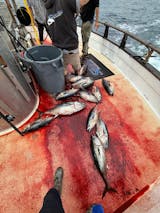The name “Opsin” wasn’t born in a boardroom or marketing meeting. Like many great fishing ideas, it started with a six-pack of beer, a late-night conversation, and an unexpected deep dive into a scientific article. That article revealed something fascinating about how fish like bluefin tuna, swordfish, and marlin see in the deep ocean. Their vision isn’t just good—it’s extraordinary, and it’s all thanks to a light-sensitive protein called opsin.
What Is Opsin?
Opsin is a protein in the eyes of all vertebrates, including fish, that works with light-detecting cells to turn light into vision. But in fish, particularly deep-water predators, this protein takes on a whole new level of importance.
In the dark depths of the ocean, where light fades quickly, predators like bluefin tuna, swordfish, marlin, and mahi-mahi rely on their vision to detect the faintest movements of prey. Their eyes are packed with specialized opsins, allowing them to process light at a range of wavelengths. This means they can pick out movement and details in dim blue waters, where other animals see almost nothing.
It’s not just about detecting light—it’s about adapting. Fish like swordfish have evolved to hunt at extreme depths where sunlight barely penetrates. Their opsins are fine-tuned to see in these conditions, making them some of the most effective hunters in the ocean. Marlin and tuna, on the other hand, are masters of speed and precision. Their eyes, with a dense concentration of opsins, allow them to track fast-moving prey like squid and smaller fish, even when light is scarce or the water is murky.


Why Opsin Matters in the Natural World
The underwater environment is a constant challenge. Fish vision isn’t just about seeing—it’s about survival. Superior eyesight gives predators the ability to strike at the right moment, track prey with razor-sharp precision, and thrive in an environment that can be unforgiving.
It’s no accident that the ocean’s most formidable species, like bluefin tuna and swordfish, have some of the most advanced vision in the animal kingdom. Their reliance on light-processing proteins like opsin ensures they see clearly, even when conditions are far from ideal.

A Name That Honors Nature and Science
When we stumbled onto this idea, it just clicked: Opsin wasn’t just a name. It was a reflection of something much bigger—of nature’s ability to adapt and evolve, and of the science behind every successful hunt in the ocean. Just as fish depend on opsins to navigate, hunt, and thrive, we as anglers depend on tools that perform reliably under the toughest conditions.
The name “Opsin” ties together our love of fishing, our respect for the natural world, and our commitment to clarity and precision. It’s not just a story about a late-night conversation—it’s a story about the very thing that helps fish survive and keeps anglers chasing them.
So, the next time you’re on the water, think about what’s happening below the surface. Fish like bluefin tuna and marlin are seeing their world with incredible clarity, guided by the science of opsins. And now, you know the story behind the name Opsin—a name inspired by the same vision that makes the underwater world extraordinary.







